What is Truth?
Our need for truth depends on our need for certainty. How do we know what truth is? What do we mean by truth? Here's a practical approach.

As human beings, it often seems we’re obsessed with knowing what is true and what’s not. Whether it’s our need to take someone at their word, or our ability to sift the real from the fake, or our reputation for figuring out what’s really going on so we don’t get taken for fools. And if we can do so before anyone else, it might even give us some advantage.
Our need for truth is a need for certainty
Our need to know what is true and what is not stems from our need for certainty. Once we have certainty, we get to make decisions and act in ways that match our goals rather than hinder them. It’s like putting our foot down on the gas pedal when the road ahead is clear rather than hesitating because we’re unsure what’s round the next corner.
But our constant need for certainty creates something of a conundrum for us as human beings—because the only way we could be absolutely certain is if we could know everything. Doing so, however, would require us being everywhere all at once—as well as being able to see into the future and the hidden intents of others, which is never going to happen, though it doesn’t stop some human beings from trying.
So instead, we prioritise. We focus on the parts of ‘everything, everywhere, all at once, now and into the future’ that we consider most relevant to us, given our limitations as finite human beings. And as long as we can be reasonably certain about whatever comes within our own sphere of influence and/or action, we stand a chance of swinging the odds in our favour.
That’s why truth is so important to us. We want the way we perceive the universe (and all that’s in it) to match how things really are.
What do we mean by truth?
But what do we even mean by ‘truth’? Let’s begin with some examples to see if we can intuit an answer.

Imagine we pick up a chunk of bread because we’re hungry.
Past experience tells us that bread will stop our feelings of hunger and will generally be good for us. We can roughly predict what it will taste like, how it will feel in our mouths, and we’re confident it won’t make us sick. You could say we idealise that chunk of bread and want our experience of it to match our internal idea.
So if it turns out to be made of papier-mâché and tastes like newspaper and wallpaper paste, there’s a mismatch between how we idealised the bread and how it really is. Not only were we unable to depend on our idealisation to predict the outcome of our actions but we were also unable to depend on the ‘bread’ to meet our goal of satisfying our hunger.
A recipe for knowing truth?
Let’s break down what’s happening in this example:
- We used our senses to perceive something external to ourselves, in this case the ‘bread’.
- This ‘something external’ appeared to match our internal idea of what that something was – “That looks like bread!”
- This internal idea was linked to a collection of memories about our own relationship with that ‘something external’ — “I like bread. I can use it to make sandwiches, dip into soup. It’s baked in an oven…”
- This remembered relationship includes the capacity of this ‘something external’ to help us fulfil a goal – “I can eat bread to stop me feeling hungry.”
- We then act on this ‘something external’ in accordance with our current goals – if we’re hungry, we attempt to eat it; if we’re angry, we might throw it.
- When we act on our internal idea, that’s normally when we discover any mismatch between our expectations and reality.
Had the ‘something external’ matched our internal idea—including the relationship we believed we had with the object because it was bread—we would have considered it all to be ‘true’. The bread would be ‘true’; our perception of it would be ‘true’; our internal idea of it would be ‘true’.
So ‘truth’ appears to have something to do with everything matching, no matter how much information we gather about it.

Other people and our perception of truth
If we had then told someone else that it was a chunk of bread and that it would satisfy their hunger, we would be “telling them the truth”.
Their ‘internal idea’ would also match the ‘something external’. But their ‘something external’ would additionally include our pronouncement that it really was bread, because the information we are giving them now forms part of the internal idea (assuming they believe us).
They would trust us, a word that is etymologically related to the word ‘truth’, and we would be considered trustworthy.
Their reliance on our truth-telling would be even more important for them if they could not see the bread themselves. In which case, they would have to ‘borrow’ our vision and our appraisal (based on our vision). In effect, they would be outsourcing their personal quest for truth to another, us.
So our pronouncement that:
- “This is bread and it will satisfy your hunger”
Must now match:
- Our internal idea
- Their internal idea
- And the ‘external something’ we both have in common.
If all four things do not match, we will consider it to be not the ‘truth’. In fact, the more things that get added to this network of connectedness involving the bread, the more things must match for us to consider it to be ‘the truth, the whole truth, and nothing but the truth’.
Which means that all it would take not to be ‘the truth’ is for one of the things in that network of connectedness not to match. That wouldn’t necessarily mean all would be false. It could be partially true, of course. But that’s for another article.
When belief deviates from truth
For now, let’s simply consider what happens if the bread was actually fake but we genuinely believed that it really was bread when we told someone else it would satisfy their hunger?
✅ Our pronouncement matches our own internal idea
✅ Our pronouncement may even match their internal idea (because their internal idea depends on our pronouncement which depends on our internal idea)
❌ It does not match the ‘something external’.
Consequently, it is not ‘truth’.
The belief that something is ‘true’ does not make it ‘true’, no matter how genuine or strong our belief.
(We will postpone a discussion about deceit for another article.)
So our internal idea must match the ‘something external’ in every way, which means:
To know the truth about ‘something’, we must have sufficient information to get a match between our internal idea and the ‘something’ that does not contradict the match we would get IF we knew everything there was to know about that ‘something’.
This suggests that if our current belief about something is ‘on the right track’, all the information we subsequently encounter will ultimately match that belief even if we deliberately seek out information that could refute it. And if it doesn’t match? Then the only ‘truthful’ thing we can do is either update our original belief, or maybe hold onto our belief a little less dogmatically and a lot more humbly.
Can we ever possess the truth?
We don’t necessarily need to know everything about ‘something’ to possess the truth… but the information we do have about it must match the information we would have if we had ‘complete’ knowledge of that ‘something’. There are, of course, many, many ‘somethings’ we encounter in life where it is just not possible to have complete knowledge about them. (Other people for a start.)
So there is clearly a relationship between truth, knowledge (in terms of the information we have) and belief.
Can we unravel this relationship a bit further?
More importantly: can knowing how to differentiate between truth, knowledge and belief help us navigate a world in which so many of us hold beliefs that conflict with the beliefs of others?
Clearly such conflicting beliefs can’t all be right, can they? But does that mean they’re all wrong? How, then, do we decide between them?
That’s what we’ll look at next, in Differentiating Truth, Belief and Knowledge

